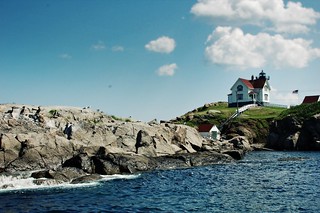
The speed with which acid levels have risen in the oceans has “caught scientists off-guard.” (Image by B Tal via Flickr)
The Christian Science Monitor reports that the speed with which acid levels have risen in the oceans has “caught scientists off-guard.” Ocean acidification was recently described by National Oceanic and Atmospheric Administration (NOAA) Administrator Jane Lubchenco as climate change’s “equally evil twin,” representing one of the biggest threats to life in the oceans. Lubchenco warned that acidification amounts to “osteoporosis of the sea” and threatens coral reefs, food security, and tourism around the world.
Scientists initially assumed that the carbon dioxide absorbed by the water would be sufficiently diluted as the oceans?mixed shallow and deeper waters. But most of the carbon dioxide and the subsequent chemical changes are being concentrated in surface waters, Lubchenco said.
“And those surface waters are changing much more rapidly than initial calculations have suggested,” she said. “It’s yet another reason to be very seriously concerned about the amount of carbon dioxide that is in the atmosphere now and the additional amount we continue to put out.”
Higher acidity levels are especially problematic for creatures such as oysters, because acid slows the growth of their shells. Experiments have shown other animals, such as clown fish, also suffer. In a study that mimicked the level of acidity scientists expect by the end of the century, clown fish began swimming toward predators, instead of away from them, because their sense of smell had been dulled.
…Read the full story at Ocean acidity increases surprise researchers – Christian Science Monitor

Study: More Than 90 Percent of Dead Pacific Northwest Seabirds in Pacific Northwest Had Ingested Plastic
/in Ocean Newswire/by Ocean DoctorA pair of northern fulmars (Photo: annecarringtoncotton via Flickr)
There is great concern about the impacts of plastics on marine wildlife in the Pacific, but much of the focus has been in tropical regions like the Northwestern Hawaiian Islands. A new study in Marine Pollution Bulletin and reported by Discovery News shows that plastics are impacting seabird populations in the Pacific Northwest as well, a region that researchers have compared to the highly-polluted North Sea with respect to plastic pollution.
Read more
Do Dolphins Hunt with Mathematics?
/in Ocean Newswire/by Ocean DoctorWhite Spinner Dolphin (Photo: SteveD. via Flickr)
We know dolphins are smart, but a study in the Proceedings of the Royal Society A by Timothy Leighton at the University of Southampton, UK, raises the question as to whether dolphins are actually using complex nonlinear math tricks to hunt. Dolphins sometimes create a “bubble curtain” to corral and concentrate prey like sardines, making it easier to pick them off. But dolphins rely on their sonar when hunting, and all those bubbles would seem to interfere with a dolphin’s ability to distinguish its prey. Bubbles certainly interfere with man-made sonar systems. So the researchers wondered if dolphins, which vary the amplitude of their sonar clicks, use a complex nonlinear processing function to essentially separate the noise from the target. In their experiment, they used such mathematical functions to process the echoes of dolphin-like pulses from targets shrouded in bubble clouds. Read more
Aquarius — World’s Last Undersea Lab — Loses Funding, Faces Decommisioning
/in Featured, Ocean Newswire/by Ocean DoctorAquarius Reef Base (Photo: NOAA)
For 25 years, the Aquarius Reef Base, an undersea laboratory that sleeps six?off of Key Largo, has served as host to numerous marine biologists and NASA astronauts. Even the Ocean Doctor has paid a visit to Aquarius. But after years of declining budgets, the Obama administration has eliminated the base’s funding, and the world’s last remaining undersea lab is faced with decommissioning — or finding its own funding. NPR reports that Dr. Sylvia Earle and other researchers are now conducting a mission of outreach and education in Aquarius to help save it.
Read more
Judge Approves $880 Million Everglades Restoration
/in Ocean Newswire/by Ocean DoctorThe Everglades (Photo: slack12 via Flickr)
The Environmental News Network (ENN) reports that a federal judge has approved an $880 million plan to restore the Everglades, a decision that could result in the settlement of numerous lawsuits spanning 25 years. In addition, U.S. Agriculture Secretary Tom Vilsack visited Kissimmee, Florida to announce an infusino of an additional $80 million from the federal government to support farmers and ranchers who voluntarily conserve wetlands on agricultural land in the northern portion of the Everglades Ecosystem. Read more
Plastic Pollution Could Promote Interbreeding, Reduce Biodiversity
/in Ocean Newswire/by Ocean DoctorExposure to Bisphenol A (BPA) from plastic pollution could accelerate interbreeding of native species with exotic species, like the red shiner (pictured). (Image by TimeScience via Flickr)
An article in Evolutionary Applications raises concerns about the impacts of plastics in aquatic environments. It has already been well-documented that Bisphenol A (BPA) affects animal development and behavior because it mimics the hormone estrogen. Consequences can include impairing the ability of males to produce offspring. New Scientist reports that the new study, led by Jessica Ward of the University of Minnesota in Saint Paul, demonstrates effects that have further consequences with serious implications for biodiversity.
The U.S. Food and Drug Administration rejected calls to ban BPA from all plastic food containers earlier this year.
Where Sea Turtles and Fishing Boats Meet
/in Ocean Newswire/by Ocean DoctorA leatherback sea turtle hatchling makes its way to the sea (Image by Jual via Flickr)
A study published in the April 2012 issue of Ecological Applications uses satellite telemetry data to identify danger zones where sea turtles and fishing trawlers intersect at sea — with deadly consequences. The insights provided by the study will assist regulatory agencies determine limits to fishing, such as seasonal closures, to protect sea turtles, all seven species of which are considered endangered.
Rapid Rise of Ocean Acidity Surprises Scientists
/in Ocean Newswire/by Ocean DoctorThe speed with which acid levels have risen in the oceans has “caught scientists off-guard.” (Image by B Tal via Flickr)
The Christian Science Monitor reports that the speed with which acid levels have risen in the oceans has “caught scientists off-guard.” Ocean acidification was recently described by National Oceanic and Atmospheric Administration (NOAA) Administrator Jane Lubchenco as climate change’s “equally evil twin,” representing one of the biggest threats to life in the oceans. Lubchenco warned that acidification amounts to “osteoporosis of the sea” and threatens coral reefs, food security, and tourism around the world.
Coral Reefs Collapsed, then Recovered After 2,500 Years
/in Ocean Newswire/by Ocean DoctorImage by nashworld via Flickr
In a study led by Lauren T. Toth at Florida Institute of Technology published in the journal, Science, coral reef ecosystems in the tropical eastern Pacific “collapsed for 2500 years, representing as much as 40% of their history, beginning about 4000 years ago.” A series of powerful El Nino events, which include periods of significantly warmer ocean temperature every three to seven years, coincided with the 2,500-year period of coral decline. This was followed by a cycle of La Nina events characterized by much cooler water, beginning 3,200 to 3,800 years ago. Corals recovered during the millenia since but now face a return to extreme weather conditions like those that wiped them out, due to climate change impacts. Read more
Sea Level Rise Now Believed Impossible to Prevent
/in Featured, Ocean Newswire/by Ocean DoctorCaloosahatchee River at Gulf of Mexico, Southwest Florida (Photo by Whitney Gray, Florida Sea Grant)
The Journal Nature reports that, despite our best efforts to reduce fossil fuel emissions, sea level rise associated with climate change is unstoppable, even under the most aggressive actions on greenhouse gas mitigation. According to the study, the question now is not if sea level rise will continue but to what degree. And that’s the good news. Without concerted mitigation strategies, scientists predict that future sea level rise would be substantial and continue to rise for centuries to come.
Read more
World’s Largest Animals, Blue Whales, Threatened by Strikes from Ships
/in Ocean Newswire/by Ocean DoctorGreat Whales Near the Farallones, California Coast (Photo by Dan Shapiro, Courtesy of NOAA)
Whale populations, still recovering from centuries of hunting, continue to face a myriad of threats. But it’s often a surprise that one of the leading causes of death among whales around the globe is ship strikes. Now researchers are concerned that blue whales — the largest animals that have ever lived on the planet — are especially vulnerable to ship strikes in the Indian Ocean, according to the New York Times:
Read more